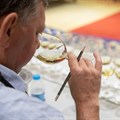SA wine industry making adjustments for climate change, adapting for sustainability

While the South African wine industry has been under great financial pressure since the start of Covid-19 due to the previous and current restrictions on liquor sales and wine tourism, as well as the resulting carry-over stock that have an effect on price points, Christo Conradie of Vinpro says now is the time to focus on the positive and build on it: “Our current export figures are looking good – even better than in 2019 – in terms of volume, but especially value growth. South Africa's cultivar wines are doing particularly well in overseas markets, including Chardonnay, Sauvignon, Shiraz, Cabernet Sauvignon and Merlot.”
There is also a revival in the planting of new vineyards, with about 2,000ha that are estimated to be established by the end of 2021. “These vines are being planted on a large scale by producers across the wine grape growing regions, with different business models – from producer to private cellars. More importantly, it’s the right cultivars that are being planted on the most appropriate sites for the specific wine purpose. We can definitely draw inspiration from this,” Conradie says.
With an increase in consumers’ awareness of ethical and environmentally friendly practices, South African wine businesses can benefit from emphasising their participation in the industry's ethical trade accreditation (Wieta). “A total of 72% of the 2021 wine grape crop, and 77% of our 92,000ha under vineyards are Wieta certified. We can proudly build on this and spread the message to an international audience.”
Buffer yourself against climate change
Climate change is a reality. According to Dr Etienne Neethling of Vintage Master and Grappe-Esa-Inra in France, an increasing number of wine grape producers from around the globe are observing the effects of climate change on their farms, and making adjustments in their vineyard practices.
According to a survey among 3,625 wine grape producers in 18 countries, 84% of the respondents are observing signs of climate change, including an increase in average winter and summer temperatures and the occurrence of unusual droughts, hail and frost in certain regions. Wine grape vineyard’ phenological stages are kicking off earlier than normal and some countries have recorded smaller yields, which they attribute to climate change.
The producers who took part in the survey provided diverse feedback on the adjustments they plan on making in the vineyard to buffer the effects of climate change, including cultivar selection, irrigation practices, disease and crop control, as well as soil management.
Best irrigation practices
Scarce water resources can be managed efficiently, while at the same time producing good yields and quality in the vineyard. “Producers can use a number of tools to guide them in terms of irrigation scheduling,” says Dr Philip Myburgh of ARC Nietvoorbij. “Large volumes of water have been saved without compromising quality or production.”
“To measure is to know,” says Francois Viljoen of Vinpro's Gen-Z Vineyard Project. Various aids are available to measure the water status in the soil and plant, including evapotranspiration measurements and the use of soil samples, soil moisture meters, tensiometers, pressure bombs, stem shrinkage measurements and remote sensing by means of infrared thermography. “There are pros and cons to the respective tools, but ultimately they must form part of an integrated approach,” Myburgh says.
According to Viljoen, an irrigation programme must first consider the specific wine end goal of the specific vineyard block. If the wine grapes are intended for premium wines, smaller amounts of water will be applied less frequently than, for example, in wine grape blocks whose grapes are intended for bulk wine. In addition to the various devices available to measure soil and plant water status, growers should also look at physical signs of water stress in the vineyard, and consider weather forecasts before scheduling their irrigation.
“Most importantly, producers need to do their homework thoroughly and use the available data to make smart decisions in the vineyard,” Myburgh says.
Control diseases and pests wisely
By applying disease and pest control judiciously, wine grape producers can save costs, reduce resistance to these chemicals and limit their chemical footprint. According to Marius Ras of Ras Consulting, a spray programme must adjust its droplet size, solution volume and the air momentum of the spraying equipment according to the leaf density and target depth. “The ultimate goal is for the fungicide or pesticide to cling to the vine surface. If the drops are too large, it will bounce off the surface,” Marius says. He advises producers to use less than 1,000 litres of solution per hectare for disease and pest control, to ensure optimal atomisation, transfer and deposition.
“There are not many chemicals available to the wine industry and, if used repeatedly, diseases and pests can quickly build up resistance to them,” says Brahm Jonker of FieldBugs. “We must therefore use the insecticides we have at our disposal responsibly by following a more integrated approach that combines biological control and ‘softer’ chemicals.”
Mealybugs are one of the hardiest vine pests that quickly build up resistance to chemicals. “Fortunately, they cannot build up resistance by being eaten by biological predators such as the wasps Anagyrus pseudococci and Coccidoxenoides perminutus or the so-called 'mealybug destroyer' Cryptolaemus montrouzieri,” Jonker says.
Winetech and Vinpro host the regional information sessions annually in May and September to share the latest technology, best practices and research with wine grape growers, viticulturists and other stakeholders. “It is important for us to constantly exchange this knowledge in the industry, so that we can continuously apply world standards in vineyard management and thus ensure a more sustainable and responsible industry going forward. We are grateful to Winetech for making these days possible,” says Conrad Schutte of Vinpro.
















